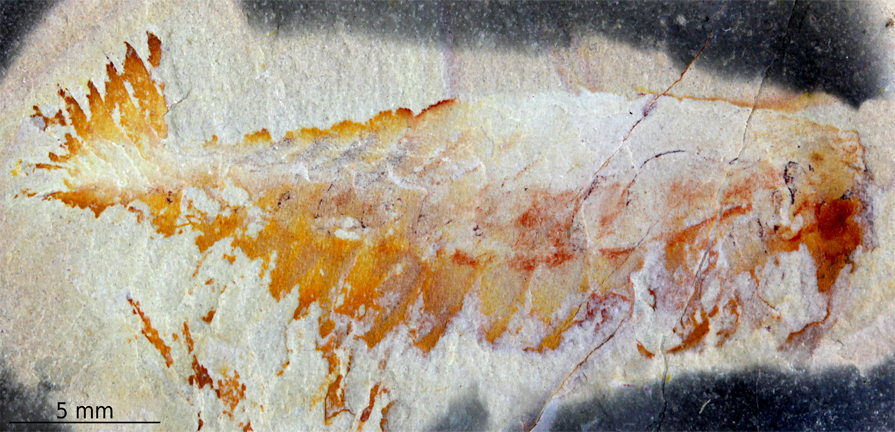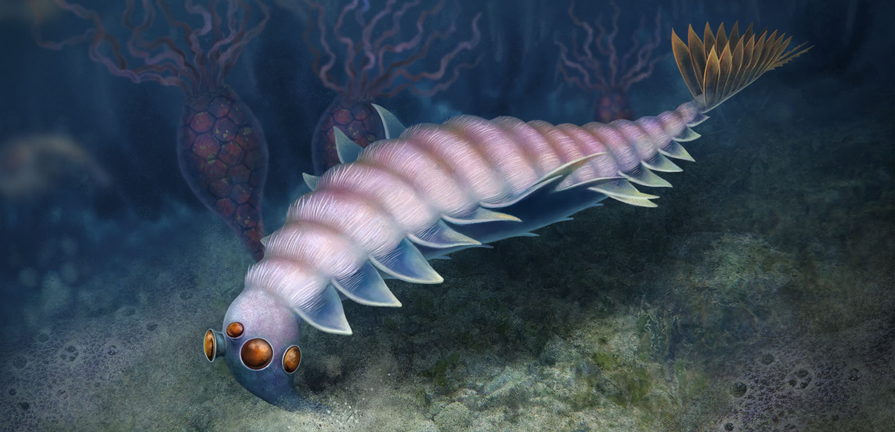
Submitted by Rachel Aucott on Tue, 08/02/2022 - 09:45
Opabinia, Anomalocaris and other ‘weird wonders’ of the Burgess Shale, remain iconic in popular culture and continue to offer insights into the early evolution of animals. During the 1970-80s Researchers at Cambridge University led transformational work that recognised that these superficially strange animals were actually extremely important for understanding the evolution of major modern groups – Opabina and Anomalocaris belong on the branch of the tree of life leading to modern arthropods.
Over the last few decades, over two dozen close relatives of the so-called ‘terror of the Cambrian’ Anomalocaris, with its radial mouth and spiny grasping appendages, have been recognised. However, the five-eyed Opabinia with its distinctive frontal proboscis remains the only opabiniid ever discovered. That is, until now. In this international collaboration, Pates, Wolfe and coauthors use cutting edge phylogenetic methods and visualization to support the description of a new taxon, Utaurora comosa, as the first new opabiniid for over 100 years and just the second-ever recognised. Their paper New opabinid diversifies the weirdest wonders of the euarthropod stem group. was published today by Proceedings of the Royal Society B today
Dr Stephen Pates, a member of the Deep Time Ecology group in Zoology, explains more about this exciting discovery with co-lead author Dr Joanna M Wolfe, a member of the Lab for Invertebrate Palaeontology at Harvard University
What does the name Utaurora comosa mean?
Utaurora: Fossil from Utah, named after Aurora (the Roman goddess of the dawn who turned her lover into a cicada – a modern arthropod). Comosa: reflects the ‘hairy’ appearance of the dorsal surface, and tail fan composed of many ‘leaves’
What makes Utaurora comosa an opabiniid?
Opabinia is most recognisable from its frontal proboscis, Utaurora has an anterior structure that is poorly preserved but that may also be a proboscis. However, there are other, more definitively observed, morphological features that are shared like intersegmental furrows along the back (maybe a precursor of body segmentation) and paired serrated spines on the tail
Why are stem group arthropods important?
A stem group is the extinct group most closely related to a living group. e.g. dinosaurs are the stem group of birds. Modern arthropods are the most successful group in animal history and are characterized by jointed appendages, tough exoskeleton, and segmented body.
The living groups most closely related to arthropods are velvet worms and tardigrades who do not have these features. So fossils within the arthropod stem group help resolve how and in what order these characteristics evolved because they display different character combinations. The “lower” stem group of arthropods, including opabiniids, chart the evolution from a common ancestor with velvet worms.
Opabiniids are the first group to have a posterior-facing mouth, while the dorsal intersegmental furrows and lateral swimming flaps are precursors to full body segmentation.
This study redescribed a museum specimen – how come it wasn’t recognised as an opabiniid before?
The specimen was first described as a radiodont over a decade ago, at a time when we thought that opabiniids and radiodonts formed a monophyletic group (so-called ‘dinocarids’). Now we know that these animals represent distinct stages of evolution on the branch leading to modern arthropods.
Over the last 10-15 years our understanding of radiodonts has expanded dramatically, and we now know that opabiniids and radiodonts are slightly different. We can now compare our improved knowledge of radiodonts to previously collected specimens, to better understand them.
What novel phylogenetic methods were used? What is a treespace?
A published phylogenetic tree represents a consensus of likely results. When palaeontologists say a grouping is supported, the set of likely results are all incorporated into that estimate (which is usually not very strong, with morphological data as opposed to DNA). In this paper we applied a visualization of all the likely phylogenetic trees retrieved by our data, aka a treespace.
We did not invent treespace, but we are the first to our knowledge, to map it by colour depending on the relationships of a specific fossil. This allows us to understand the consistency of our results based on the evolutionary models used.
Why is discovering a new opabiniid so exciting for the authors on a personal level?
For many amateur and professional palaeontologists – especially millennials and including some authors of the study - Gould’s Wonderful Life (published in 1989) was one of their first exposures to palaeontology and the Cambrian Explosion. Gould enchantingly described Opabinia as the “fulcrum of his narrative” and noted he would switch to another font colour if he could, to explain the importance of this species in his view of early animal evolution.
At least one author (JMW) became a palaeontologist in the first place with the specific dream of studying Opabinia. So to describe Utaurora, the second opabiniid, is very exciting on a personal level as it links back to some of our first exposures to palaeontology.
Publication details
Stephen Pates, Joanna M. Wolfe, Allison C. Daley, Rudy Lerosey-Aubril, Javier Ortega-Hernández. (2022) New opabinid diversifies the weirdest wonders of the euarthropod stem group. Proceedings of the Royal Society B. DOI: 10.1098/rspb.2021.2093
Image Details
Top: Utaurora comosa from the Wheeler Formation, Utah, USA (Cambrian: Drumian). Holotype and only known specimen accessioned at the Division of Invertebrate Palaeontology in the Biodiversity Institute at the University of Kansas. Photograph by S. Pates.
Middle: Artistic reconstruction of Utaurora comosa from the Wheeler Formation, Utah, USA (Cambrian: Drumian). Artwork by F. Anthony.
Funding and specimen information
Funding was provided by the Alexander Agassiz Postdoctoral Fellowship (Museum of Comparative Zoology at Harvard) and a Herchel Smith Postdoctoral Fellowship (University of Cambridge). Additional support was provided by the National Science Foundation (DEB-1856679). The specimen is accessioned at the University of Kansas Division of Invertebrate Palaeontology, Biodiversity Institute.
Read more in the New York Times and Science Alert

